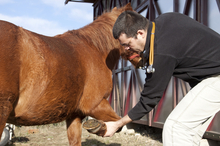For most horse owners, the discovery of a horse that appears to have gone lame over night is a major headache. Not only does the lameness keep the horse owner from going about regular business, but it often means having a veterinarian make a diagnosis and giving the horse time to recuperate from whatever is causing the lameness.

Preventing lameness in horses
With the help of regular shoeing to restore the correct mechanical balance of the limbs and feet of affected horses, the development of the syndrome leading to navicular disease may be prevented.
If the lameness happens to be navicular disease, the prognosis is not always good. A recent study in Britain came to some conclusions that may be helpful to many horse owners.
Although navicular disease in horses is usually diagnosed only when obvious lameness is present, it is possible, for a careful observer to recognize clinical signs some 18 to 24 months before the onset of lameness. Researchers dubbed this state as ‘pre-navicular syndrome.’
In short, navicular disease is a chronic progressive forelimb lameness and is the final stage of a clinical syndrome. In the study, the majority of horses in that exhibit signs within the navicular syndrome seemed to share one factor, that of anterior-posterior hoof-pastern imbalance, which may or may not have been complicated by hoof imbalance.
Under such conditions, greater weight is borne by the caudal parts of the foot, rather than distributed over the entire ground surface of the wall and bars, as it should be. the direct result is that the heels collapse under excessive pressure and become under-run, thus failing to support one foot. Once this process of collapse has begun, it becomes self-perpetuating, as the angle of weight-bearing becomes greater and greater.
As a consequence, the structures within the foot are subjected to abnormal stresses and pressures, and venous congestion occurs, nutrition to the bone in impaired, and, if left unchecked, this condition leads to arterial sclerosis and thrombosis, resulting in death of tissues. Spur formation on the navicular bone may begin.
If farriers and veterinary surgeons recognize the signs of the changes in the horse’s behaviour, gait, feet, and shoe-wear an early diagnosis of thiis developing syndrome is very possible before the condition develops into navicular disease.
With the help of regular shoeing to restore the correct mechanical balance of the limbs and feet of affected horses, the development of the syndrome leading to navicular disease may be prevented and a permanent and effective cure can be obtained.
